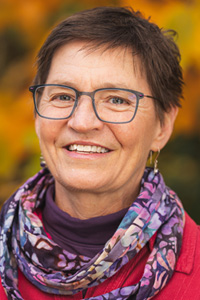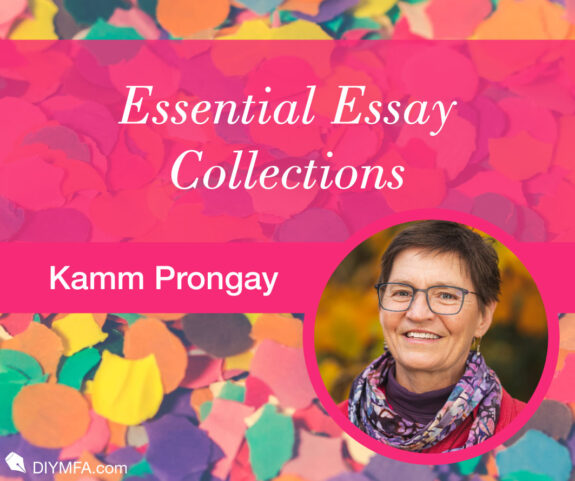I can’t encircle the trunk with my arms or see the top. Douglas Fir trees are like that. 500-year old giants, they stretch straight to the sky, snag clouds, and create their own weather. The bark smells of cinnamon and moisture, and if I am not careful, it will leave a scratch or two on my forearms. It would be easier to measure the circumference with a measuring tape, but then we couldn’t trade breaths, the tree and I.
Kamm Prongay
A single tree holds enough wood to build three or four houses. If I press my ear to the trunk, I can hear the water going up, and feel the great heart of the tree beat in time with the wind. I am too close to count branches. I have to step back, way back, build distance. Only then can I see the tree, and hear all the species she houses and feeds.
Douglas Fir distance, I call it—the distance required for perspective, learning, and growth.
I love reading essays almost as much as I love Douglas Fir trees. I require an afternoon snack of tea and cookies for my body, an essay or two for my brain. But to read like a writer, I must move from mere consumer to student, and to do that, I need a deep understanding of an essay’s conventions, structures and expectations.
When I Google “Essential Essay Collections” and get more ‘top 10, top 25, top 100 collections’ than my eyes or pocketbook can handle. Do I start with Montaigne or Didion, short form or long, formal or informal, personal or travel? If I read this author, what other authors do I ignore?
I need distance, Douglas Fir distance, to sort out which writers deserve my attention and space on my bookshelf. But how?
After several days of overwhelm, cross referencing various ‘must read’ lists, I find a solution. Combining Anthologies, ‘Best Of’ Collections, and a select few favorite authors lets me approach the richness of essay without feeling guilty about all the authors and essays I don’t have time to read.
Anthologies
Essay anthologies offer an easy entry into the genre. Most collections provide examples of early essay forms and topics. Anthologies are also available in various subgenres, but I prefer more inclusive collections.
My first acquisition was Phillip Lopate’s The Art of the Personal Essay: An Anthology from the Classical Era to the Present. In one (admittedly large) volume, I have 2000 years of personal essay examples on everything from ambition to education and death. Part I introduces me to early essayists, like Seneca, Plutarch, and Michel de Montaigne. The anthology also includes writers from multiple continents, and provides examples by form, including memoir, book review, humor, and lecture. Complementing the rich collection, Lopate’s introduction highlights the key components of a good essay, conversational element, honesty, egotism, irony, and other questions of form and style.
Samuel Cohen’s 50 Essays, a Portable Anthology, is a nice compromise between size, price, and variety. At 503 pages, the text is one-third of Lopate’s, was updated in 2023, and includes some newer writers.
‘Best Of’ and Literary Magazines
Anthologies are great for understanding past writing trends, but don’t include new writers or diverse voices. To fill this gap, I look to current work. HarperCollins’ Best American Series showcases the best non-fiction from the preceding year. Series editors select works from online and print, then a guest editor chooses the final pieces for publication. The nonfiction has been so popular it recently expanded to include two other essay collections, The Best American Science and Nature Writing, and The Best American Food Writing.
I also search for collections published by nontraditional houses. Two recent discoveries are Shapes of Native Nonfiction, a curated collection of non-fiction writing by 27 contemporary Native writers, and Bending Genre: Essays on Creative Nonfiction, a collection of essays exploring the notion of genre and creative nonfiction.
Literary magazines (Orion, Brevity, and Hippocampus, among others) also include diverse writers, and help me understand what editors are accepting. I flag essays I like, and ones I don’t, then study them to understand why.
Favorite Authors
The third section of my bookshelf is devoted to Shadow Mentors, writers whose work I read, reread, and dissect. I am picky about who gets these seats. These writers have a deep and broad body of work, create pieces that touch my thin space, remind me of the great joy and terrible aches of life.
My favorite essayists leave me wondering why I hadn’t seen a thing that way, or that I had felt exactly that way. I sample one or two pieces in an afternoon, analyze style, image, tempo, and voice.
Joan Didion’s A Year of Magical Thinking taught me to write about grief and loss with honesty and clarity. I also enjoy the breadth of Didion’s work. Her essays touch upon life and death, politics, and writing.
Shadow Mentors also inspire. When words elude me, I pick up Brian Doyle’s Joyas Voadoras. I marvel all over again how he moves from a hummingbird’s heart to a whale’s, then ties the two together with pancakes.
Populate your bookshelf
I’ve touched on a few of the anthologies and collections that inspire me, and my author shadow mentors. But essay is an expansive form, and it will continue to branch. Populate your bookshelf with whatever works resonate, inspire, and delight. As for me, I am sitting with Brian Doyle’s One Long River of Song in one hand, and a cup of English Breakfast tea in the other. I’ll go back to work, just as soon as I finish reading.

Kamm Prongay is a writer and veterinarian whose essays intertwine science, nature, people, and place. A child of the South, raised in the Pacific Northwest, Kamm spent time at sea as a Naval Surface Warfare Officer before coming ashore to pursue veterinary school, clinical practice, teaching and research. Kamm lives with her wife, Liz, and two curious cats in Portland, Oregon.
You can find her on her website.







